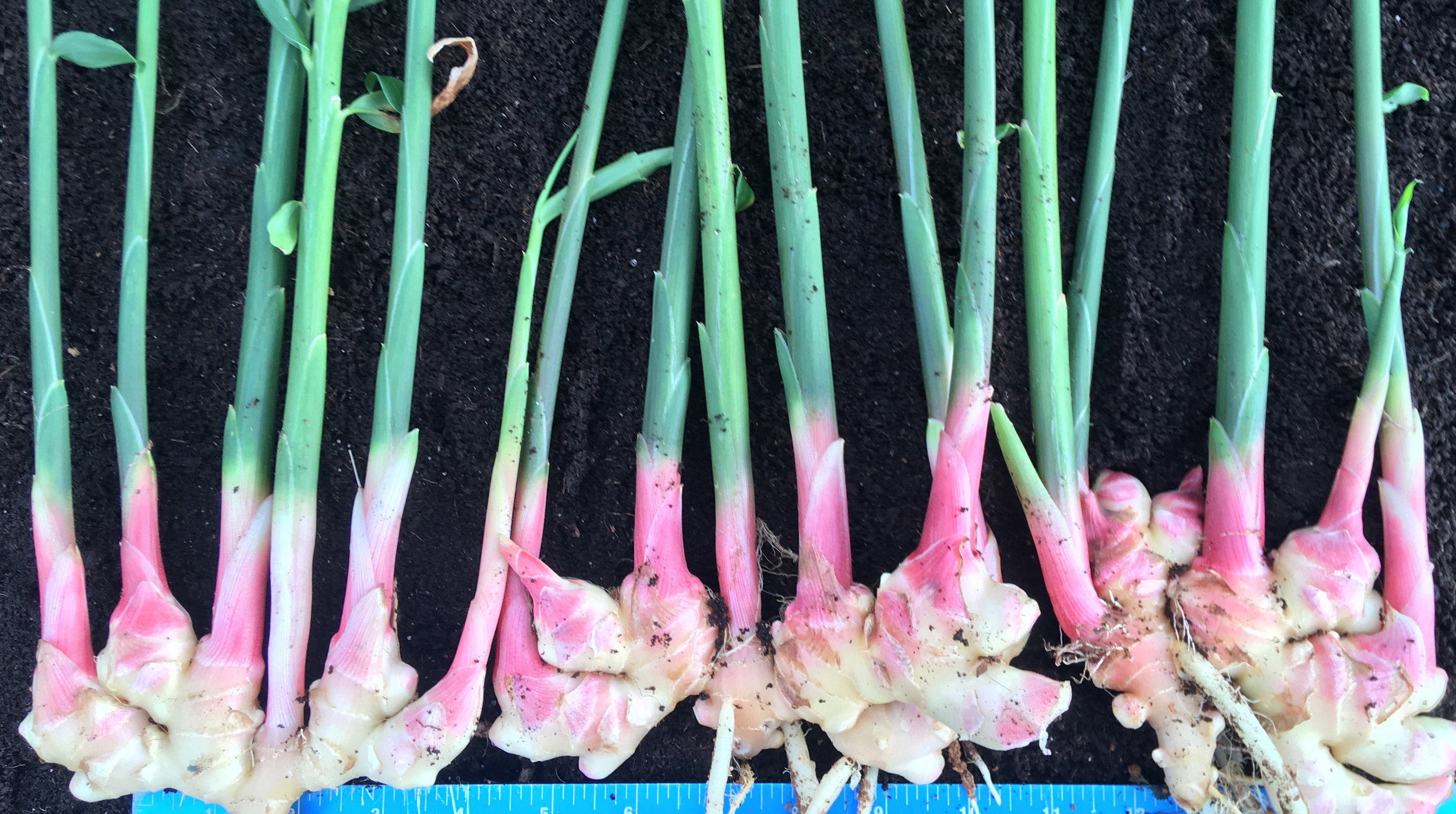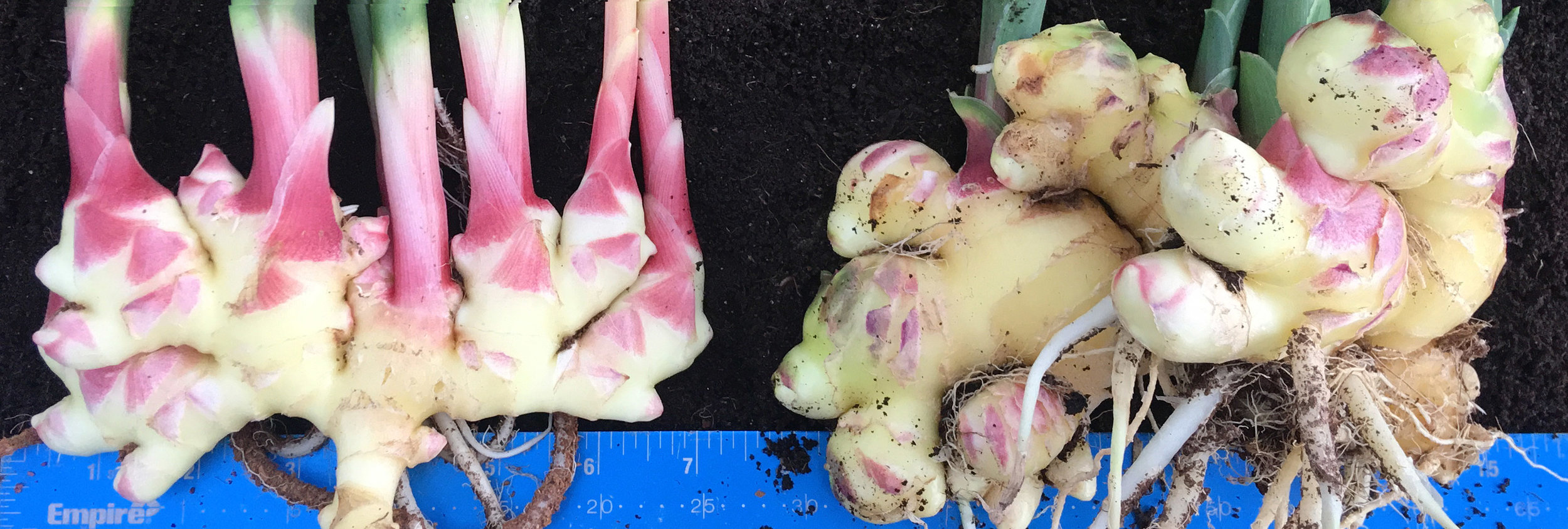The art of Storing Ginger
Over the years we have gotten a lot of questions about storing ginger.
Complex question for all it’s simplicity when asked. In this chapter we delve into the interesting world of how to put ginger on a shelf. Ginger in a jar. Ginger in a freezer and so on.
“Baby” Madonna ginger 80 days after planting.
Young Hawaiian Yellow and Khing Yai Ginger
Step one how baby is your ginger?
Determining the age of your ginger is paramount to choosing the best strategy for preserving it.
Ginger that is very young with bright pink scales and blushing will be handled differently than a more mature rhizome that has begun to develop an cuticle.
Most people will judge ginger by when it was planted or rather it’s total age. This is a fine however I like to also note the color of the scales, heat inside, fiber content and don’t forget the presence of an cuticle.
At full maturity the cuticle becomes thick, shiny and keeps the now dormant ginger from losing moisture too quickly. It should be noted the cuticle is bonded with the flesh beneath at this stage.
When the cuticle can be peeled back it is at the young/teenage stage. Most often we see this when we are washing young/teenage ginger with high pressure water. If the material is oriented with the stem end toward the nozzle the young cuticle is easily blown off and damaged.
Truly “baby” ginger has no cuticle. Just lots of hot pink scales and a pinkish glow depending on the variety. For instance Bubba blue is really pink all over where as the yellow types generally the scales are the most striking pink feature.
Starch from ginger as prepared and photographed by Patrick Callery.
Fully mature turmeric
Air flow is good.
In general airflow is the deciding factor on whether a hand of ginger rots or lasts. No is airflow bad.
Humidity of the air that is being circulated around the ginger is of importance. Too dry and your material will look like king Tut’s nuts in no time. Too wet and you will have rotten junk.
In Hawaii we have an ambient temperature of about 70 high humidity air and a light trade wind breeze. so we can just store on an open mesh table. I think if you are able to maintain 60 degrees and a decent amount of circulating humid air you will be be doing good. Just remember too dry can dehydrate and too wet can rot. We can achieve a taller stack on the table by stacking the table a layer at a time and allowing a day or two between layers.
In most parts of the world ginger is stored BEFORE washing. Growers will knock of any big clods of dirt and stack in piles with good airflow.
However in Himachal Pradesh growers build special lined holes in the ground and store their ginger in these “caves” I imagine there is no airflow in those holes, so in this dry and cold climate (Hint hint…) refrigeration is a good way to store the material. I would be careful about humidity either way in refrigerated space. I wonder if anyone will actually dig a hole in their yard? If you do please send pictures!
Speaking of refrigeration nothing below 55F / 13 C. Below that cellular breakdown can happen. Worse thing is to put in fridge take out of fridge put in fridge take out of fridge. All vegetables hate that. I think one cycle in and out is OK but it can make for rubbery young ginger. More mature ginger is more tolerant of all this thanks to it’s cuticle (skin) and rigidity. Also it should be noted that material that was exposed to cold during active growth and did fine should do better when exposed to cold than say a ginger grown in the deepest steamy jungle.
An impressive clump of semi mature turmeric
Other storage methods.
I hear people freeze it all the time. Frozen it can be sold to Juice bars, restaurants or processing applications. How long is it good in the freezer? I don’t know taste some.
Drying is good way to preserve Turmeric or ginger. On mature product the fresh to dry ratio is about 5:1 (20%) most times. If material is young it will yield a lower return percentage. Younger material will also have less essential oils and oleoresin. So drying is best suited for more mature material generally.
Drying is easily achieved by slicing the material thin and providing good airflow and super low humidity. Warm air holds more moisture so most methods of drying use warm air. For starters a thin layer of slices can be put on a cookie sheet in an very very low oven can make nice dried chips. If you have a pilot light inside your oven that can help after you have removed most of the moisture.
Make sure dried material is really dry. If you put in a bag for a few days and it becomes soft or pliable it was not dried correctly. It will mold quickly this way. You should always be able to snap a dried chip into crumbs. No one like smoking mold, just kidding don’t smoke ginger.
Pickling. Great Idea. Use young ginger. Can do with turmeric also!
Candied ginger. Great Idea. Use young ginger. Can do with turmeric also!
Ginger for ointments and rubs….what what? Gingerol from ginger is similar to capsicum in chillies chemically and in bioactivity. Pain relief cream? As you know capscicum is used for just that. Why not ginger?
Turmeric is also would be a great candidate for salves but one must be careful as turmeric can stain clothing.
Capsules- Yes. Ginger is a well known and tested treatment for those experiencing nausea. I’m sure you have read about the medicinal benefits of turmeric as well.






